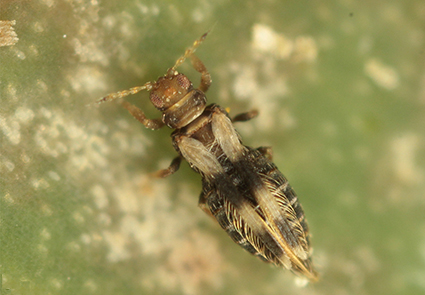References
Bulletin de Santé du Végétal Corse (2018) BSV JEVI FLASH n° 5–28 septembre 2018. Hercinothrips dimidiatus Hood sur Aloe arborescens, premier signalement en France. Available from: https://draaf.corse.agriculture.gouv.fr/Les-bulletins-de-sante-du-vegetal (accessed 28 May 2021)
Chore, J.K., Obonyo, M., Wachira, F.N. & Mireji, P.O. (2014) Larvicidal activity of selected Aloe species against Aedes aegypti (Diptera: Culicidae). Journal of Insect Science, 14, 202. https://doi.org/10.1093/jisesa/ieu064
Hood, J.D. (1937) New genera and species of Thysanoptera from South Africa. Annals and Magazine of Natural History, Series 10, 19 (109), 97–113. https://doi.org/10.1080/00222933708655243
Jones, D.R. (2005) Plant viruses transmitted by thrips. European Journal of Plant Pathology, 113, 119–157. https://doi.org/10.1007/s10658-005-2334-1
Klara, R.S., Gabor, J. & Laszlo, S.M. (1997) The occurrence of Cerataphis orchidearum (Westwood) (Homoptera: Hormaphididae) and Hercinothrips femoralis (OM Reuter) (Thysanoptera: Thripidae) in Hungarian glasshouses. Növényvédelem, 33, 239–241.
Ko, S.W., So, I.S. & Huh, M.R. (2009) Study on antifungal activity of Aloe arborescens M. for a potential bio-pesticide. Journal of Agriculture & Life Science, 43, 35–44.
Mateus, C., Franco, J.C., Caetano, M.F., Da Silva, E.B., Ramos, A.P., Figueiredo, E. & Mound, L. (2015) Hercinothrips dimidiatus Hood (Thysanoptera: Thripidae), a new pest of Aloe arborescens Miller in Europe. Phytoparasitica, 43, 689–692. https://doi.org/10.1007/s12600-015-0492-z
Masarovič, R., Doričová, M., Prokop, P. & Fedor, P. (2014) “Testing the limits”—an interesting record of the exotic banded greenhouse thrips Hercinothrips femoralis (Thysanoptera: Thripidae: Panchaetothripinae) at high Carpathian mountain altitudes. Biologia, 69, 1631–1634. https://doi.org/10.2478/s11756-014-0458-5
Moritz, G. (1994) Pictorial key to the economically important species of Thysanoptera in Central Europe. EPPO Bulletin, 24, 181–208. https://doi.org/10.1111/j.1365-2338.1994.tb01060.x
Mound, L.A. (1965) The genus Hercinothrips (Thysanoptera) with one new species. Annals and Magazine of Natural History, Series 13, 8 (88), 243–247. https://doi.org/10.1080/00222936508651564
Nickle, D.A. (2009) Commonly intercepted thrips at US ports-of-entry from Africa, Europe, and the Mediterranean. IV. Miscellaneous thripine genera excluding Frankliniella, Iridothrips, and Thrips (Thysanoptera: Thripidae). Proceedings of the Entomological Society of Washington, 111, 215–238. https://doi.org/10.4289/0013-8797-111.1.215
Poorani, J. & Thanigairaj, R. (2019) Record of Asprothrips navsariensis Tyagi as a pest of Banana from Tamil Nadu with notes on other thrips infesting Banana. Indian Journal of Entomology, 81, 434–438. https://doi.org/10.5958/0974-8172.2019.00093.2
Reynaud, P. (2010) Thrips (Thysanoptera). Chapter 13.1. In: Roques, A., Kenis, M., Lees, D., Lopez-Vaamonde, C., Rabitsch, W., Rasplus, J.-Y. & Roy, D. (Eds.), Alien terrestrial arthropods of Europe. BioRisk, 4, pp. 767–791. https://doi.org/10.3897/biorisk.4.59
Smith, G.F. & Figueiredo, E. (2009) Aloe arborescens Mill. (Asphodelaceae) is spreading in Portugal. Bradleya, 27, 165–167. https://doi.org/10.25223/brad.n27.2009.a4
Smith, G.F., Klopper, R.R., Figueiredo, E. & Crouch, N.R. (2012) Aspects of the taxonomy of Aloe arborescens Mill. (Asphodelaceae: Alooideae). Bradleya, 30, 127–137. https://doi.org/10.25223/brad.n30.2012.a15
Štefánik, M., Zvaríková, M., Masarovič, R. & Fedor, P. (2019) The significance of anthropochory with Hercinothrips femoralis (Thysanoptera: Thripidae). Plant Protection Science, 55, 262–265. https://doi.org/10.17221/51/2019-PPS
Sung, C. (2006) The history of Aloe. In: Park, Y. & Lee, S. (Eds.), New perspectives on Aloe. Springer Science and Business Media, New York, pp. 7–17. https://doi.org/10.1007/978-0-387-34636-6_2
Suplicy Filho, N. & Sampaio, A.S. (1982) Pests of banana. Biologico, 48, 169–182.
ThripsWiki (2021) ThripsWiki—providing information on the World’s thrips. Available from: http://thrips.info/wiki/ (accessed 23 June 2021)
United States Department of Agriculture (USDA) (1942) List of intercepted plant pests, 1941. Washington: USDA, Bureau of Entomology and Plant Quarantine, Service and Regulatory Annoucements. Available from: http://ufdc.ufl.edu/AA00017454/00003 (accessed 28 May 2021)
Varga, L. (2008) Hercinothrips femoralis (Reuter, 1891)—a New Pest Thrips (Thysanoptera: Panchaetothripinae) in Slovakia. Plant Protection Science, 44, 114–118. https://doi.org/10.17221/13/2008-PPS


